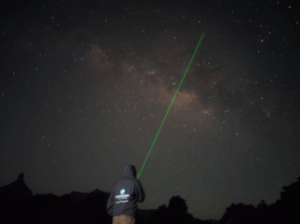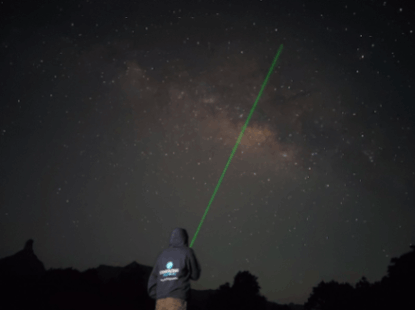Stargazing is a time-honored tradition for peering into the mysteries of the cosmos. Yet beginners can find navigating the night sky daunting at first. How do you locate faint objects or recognize star patterns?
Green laser pointers may illuminate the night sky, but reckless use risks blinding pilots and bystanders alike. When wielded responsibly, however, these glow-in-the-dark wands become tour guides to the cosmos rather than weapons of visual disruption. With care and wisdom, they transition smoothly from hazards to helpful astronomy aids for mapping the heavens.

These versatile green lasers are like a torch beam for stargazers, casting a vibrant line leading to the cosmos. Unlike broad floodlights that drown out details, the laser’s focused beam pierces through blackness to spotlight stars and planets. The special attributes of green lasers make them ideal for astronomy guidance.
The special properties of green lasers make them ideal astronomy tools. The human eye perceives green light more brightly than other colors. A 5-milliwatt green laser can appear up to 10 times brighter than a red laser of the same power. The beams also travel extremely far without dispersing. Astronauts have photographed green beams from over 200 miles away in space! The lack of atmospheric interference allows the beams to maintain coherence over vast distances.
Yet with such intensity comes risk if mishandled. Outdoor lasers can temporarily blind pilots and even damage vision with direct exposure. That’s why responsible use is so important.
Follow these safety guidelines:
– Never aim near aircraft or people
– Circle targets instead of pointing
– Limit laser time to brief bursts
– Store securely away from kids
Additionally, many countries lack regulations, though penalties in the U.S. can include fines and jail time. Unaware stargazers have faced legal consequences for interfering with passing aircraft. That’s why it’s critical to exercise caution and restraint when using lasers.
3 Key Attributes of a Laser Beam
What gives green lasers their stellar superpowers?
-
Wavelength
Green laser light concentrates around 532 nanometers on the visible light spectrum. This wavelength transmits well through the atmosphere compared to other colors.
-
Power Density
Lasers concentrate energy into a tight beam, creating high power density. A 5mW laser focuses 5 milliwatts of power into a fine point. This intensity produces visible beams even in bright urban areas.
-
Collimation
Laser beams maintain tight collimation, meaning they hold together over long distances without spreading out. The highly collimated light forms a directed path to guide the eye.
In simple terms, how laser is used in astronomy?
Adaptive optics
lasers play a crucial role in mitigating the impact of atmospheric turbulence. Devoid of adaptive optics, the observation of stars and galaxies would be marred by distortions and blurriness.
Exciting sodium particles
Particles become a thrilling endeavor for astronomers as they deploy lasers to stimulate sodium particles in the upper atmosphere, inducing a captivating radiance akin to the brilliance of artificial stars.

Lasers for Different Observation Conditions
Light pollution in developed areas can overwhelm the faint light of stars. Brighter lasers cut through the distorted glow:
Urban Skies – 10 to 30mW green lasers
Suburban Skies – 5 to 15mW green lasers
Rural Skies – 1 to 5mW green lasers
Brighter lasers also reach farther, extending range:
30mW green laser – visible up to 20 miles
5mW green laser – visible up to 5 miles
Of course, appropriate laser strength depends on the specific conditions. It’s best to start with lower power and increase only as needed.
Carefully Navigating the Cosmos
When practiced carefully, lasers grant newbie stargazers an illuminating guide to cosmic wonders. As beams sweep across the night sky, constellations shine into view and planets emerge from blackness.
Lasers can highlight:
– Bright stars like Sirius, Arcturus, Vega
– Familiar constellations like Orion the Hunter
– Elusive Mercury and distant Saturn
– Vapor trails and tumbling satellites
Astronomers also use lasers to track stars and calibrate telescopes. Concentrated beams replace awkward manual adjustments, allowing smooth automatic guiding.

So the next time you feel lost gazing at the stars, let a laser beam light the way on your journey through infinity. Wield this magical green wand to conduct the symphony of the spheres. But do so judiciously, following all safety guidelines. Share the splendor but minimize risks with care and preparation.
Immerse newcomers in cosmic grandeur, but temper intensity until their eyes adjust. Unveil the ethereal beauty glowing in the darkness to inspire budding astronomers. Let lasers ignite the passion for pursuing night sky wonders!

